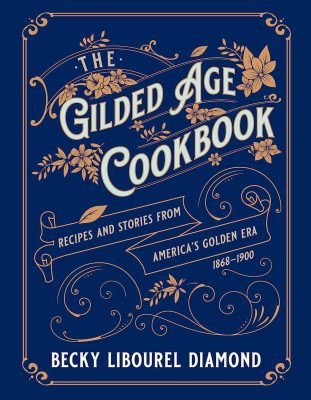“The Gilded Age Cookbook: Recipes and Stories from America’s Golden Era,” a new book by Becky Libourel Diamond, is as much a record of historical events as a cookbook.
The recipes and how they came to enter the culinary lexicon, as well as the lush photography will delight the history buff as well as those who enjoy eating and preparing meals.
The Foreword by Chef Walter Staib, host of “A Taste of History” on PBS, highlights facts about the popular foods of the period. “A common misconception,” says Chef Walter, “is that the American cuisine of previous centuries was dull, flavorless, and limited. That assumption couldn’t be further from the truth, especially in the city of Philadelphia. In the 18th century, it was the largest city in the New World, the second-largest city in the British Empire, and home to open-air markets that offered an endless bounty of the area.”
Chef Walter goes as far as claiming, “the abundance of seafood and game,” was an important motivating factor in William Penn’s decision to brave the journey to the New World, and that food soon became a large part of “the new American colonists’ identity and culture.” Chef Walter gives further credence to this claim when he points out that “In Europe, only royalty could hunt, but in America, that opportunity was available to anyone.”
In Chapter One: Culinary Innovations, Becky discusses how “An ever-expanding network of trains and fast steam ships increased the availability of many foods.” George Pullman created the dining cars “that featured an extensive menu of fine-dining options served on elegant china, crystal and silver; a luxurious setting and impeccable service.” Seventy-five cents could buy breakfast on a Pullman sleeper car that might consist of one of eight types of bread, mutton chops, sirloin steak, game, oysters, eggs, fruits, and vegetables. Dinner would consist of up to eighty dishes for a dollar. Maintaining such a high level of service came at an extreme cost,” the author points out. Recipes in this chapter include Potage Puree, Aunt Lizzie’s Pineapple Pie, and Chocolate Macaroons.
Interspersed through this chapter, as in others, are short accounts of events that affected the eating and preparing of food, such as “The Servant Issue,” Heiresses Go To Cooking School,” and “Mrs. Rorer At The 1893 World’s Fair.”
Chapter Two: Outdoor Eats describes what picnics and outdoor celebrations were like at the time. Becky offers a recipe for Saratoga Chips, the precursor of potato chips and writes rumor has it that in 1853 Cornelius Vanderbilt while dining at Moon’s Lake House kept sending back his dish of Moon’s Fried Potatoes for being too thick. “In frustration, chef George Crum sliced up some potatoes razor thin, fried them until crisp, and seasoned them with extra salt. The super-thin fried potato style took hold, and by the 1870s recipes for crispy Saratoga chips appeared frequently in American cookbooks.”
 In Chapter Three: Dining Out, the author describes how “gentlemen’s clubs” became prevalent. The Philadelphia Club was “considered the oldest gentlemen’s club in the United States.” Fish House Punch, a drink with rum and peach brandy, was served at the Philadelphia Fish House Club which was founded in 1732 originally “as a men’s fishing club by a few of the city’s original settlers.”
In Chapter Three: Dining Out, the author describes how “gentlemen’s clubs” became prevalent. The Philadelphia Club was “considered the oldest gentlemen’s club in the United States.” Fish House Punch, a drink with rum and peach brandy, was served at the Philadelphia Fish House Club which was founded in 1732 originally “as a men’s fishing club by a few of the city’s original settlers.”
Being able to read French was a prerequisite for ordering at most eating establishments, and if one didn’t know “boeuf” from “poulet,” they would have been in for a surprise when served as many menus were printed in French.
Chapter Four: By Invitation Only gives an account of the dishes often served at more formal occasions. Emphasized is that prosperous Americans of the time were willing to go to considerable lengths to impress their contemporaries. One way “they liked to ‘show off’ their excess wealth was by hosting social events in their homes, including elaborate dinner parties. These exclusive gatherings helped tighten the society circles of old money and traditional American bloodlines…” Sometimes even animal guests were invited, such as the dinner given by Elizabeth Wharton Drexel that included a dogs’ dinner, where society pets were served a three-course banquet at their own table.
Lobsters were just becoming popular. “They were once considered food for the poor,” and were so plentiful in Maine that “they were used as fish bait.”
Chapter Five: Holidays reports that for Thanksgiving, turkey was often preceded by a course of chicken pie and oyster soup, and Christmas might see families “following English tradition by serving roast goose.”
Becky Libourel Diamond is a food writer, librarian, and research historian. She has been writing about food since 2008, parlaying her passion for food and history into the publication of The Thousand Dollar Dinner and Mrs. Goodfellow: The Story of America’s First Cooking School. She resides in Yardley.
PHOTO CAPS:
- Becky Libourel Diamond
- The cover of “The Gilded Age Cookbook: Recipes and Stories from America’s Golden Era”
